8 - English
Ingredients ___________________________
Carbon Black (3-10%): IARC Group 2B “Possible
Carcinogen.”
CAS# 1333-86-4.
OSHA PEL: 3.5 mg/m
3
.
ACGIH TLV: 3.5 mg/m
3
.
LD
50
: Not available.
LC
50
: Not available.
Styrene acrylate copolymer 80-95%)
CAS# Confidential.
OSHA PEL: Not listed.
ACGIH TLV Not listed.
LD50: Not Available.
LC50: Not Available.
Wax (5-15%)
CAS# Confidential.
OSHA PEL: Not listed.
ACGIH TLV Not listed.
LD50: Not Available.
LC50: Not Available.
Silica (1-3%)
CAS# Confidential.
OSHA PEL: Not listed.
ACGIH TLV: 10 mg/m
3
.
LD
50
: Not Available.
LC
50
: Not Available.
Physical Data _________________________
Physical State:
Solid.
Melting/Freezing Point:
Not available.
Boiling Point:
Not available.
pH:
Not available.
Vapor Pressure:
Not available.
Vapor Density (Air=1):
Not available.
Evaporation Rate (Butyl Acetate=1):
Specific Gravity (H
2
O=1):
About 1.2 at 20°C (68°F).
Solubility in Water:
Negligible.
Solubility in Solvents:
Partially soluble in toluene and
tetrahydrofuran.
Coefficient of water/oil Distribution:
Not available.
Appearance and Odor:
Black powder, slight plastic odor.
Odor Threshold:
Not available.
Fire and Explosion Hazard Data ___________
Minimal fire hazard. Large quantities may cause risk of dust
explosion.
Flash Point (Method Used):
Not applicable.
Flammable Limits
Lower Explosive Limit:
Not applicable.
Upper Explosive Limit:
Not applicable.
Auto-Ignition Temperature
: Not applicable.
Explosion Data
Sensitivity to Mechanical Impact:
Not available.
Sensitivity to Static Discharge:
Not available.
Extinguishing Media:
Water, foam or dry chemical.
Special Fire Fighting Procedures:
Fight fire from upwind
position. Avoid inhalation of smoke or gases. Wear
self-contained breathing apparatus. Cool the container with
water spray.
Hazardous Combustion Products:
Carbon monoxide.
Also produces carbon dioxide.
Toxicological Properties _________________
Routes of Entry:
Inhalation, Ingestion, Eyes, Skin.
Effects of Acute Exposure:
Not available.
Effects of Chronic Exposure:
Not available.
In a study in rats of chronic inhalation exposure to a typical
toner, a mild to moderate degree of lung fibrosis was
observed in 92% of the rats in the high concentration
(16 mg/m
3
) exposure group. A minimal to mild degree of
lung fibrosis was observed in 22% of the rats in the middle
(4 mg/m
3
) exposure group. No pulmonary change was
reported in the lowest (1 mg/m
3
) exposure group, the most
relevant level to potential human exposures.
Exposure Limits (
ACGIH TLV
):
Inhalable Particulates: 10 mg/m
3
Respirable Particulates: 3 mg/m
3
Irritancy:
Not available.
Sensitivity:
Not available.
Carcinogenicity
IARC
Carbon Black:
Group 2B “Possible Carcinogen.”
This classification is given to chemicals for which there
is inadequate human evidence, but sufficient animal
evidence on which to base an opinion of
carcinogenicity. The classification is based upon the
development of lung tumors in rats receiving chronic
inhalation exposure to free carbon black at levels that
induce particle overload of the lung. Studies
performed in animal models other than rats did not
show any association between carbon black and lung
tumors. Moreover, a two-year cancer bioassay using a
typical toner preparation containing carbon black
demonstrated no association between toner exposure
and tumor development in rats.
NTP: No components are listed.
OSHA: Carbon black is designated hazardous according to
OSHA 29 CFR 1910.1200.
Reproductive Toxicity:
Not available.
Teratogenicity:
Not available.
Mutagenicity:
Not available.
Names of Toxicologically Synergistic Products:
Not
available.
Reactivity Data ________________________
Stability:
Stable in general.
Materials to Avoid:
None.
Polymerization:
Will not occur.
Hazardous Decomposition or Byproducts:
Combustion
products include carbon monoxide and carbon dioxide.
Incompatibility:
Avoid exposure to strong oxidizers.
Preventive Measures ___________________
Personal Protective Equipment
Respiratory Protection:
Not normally required. For large
spills, use dust respirator mask during cleanup.
Protective Gloves and/or Eye Protection:
Not normally
required. For large spills, use leather gloves and safety
goggles during cleanup.
Engineering Controls
Ventilation:
Outside of normal ventilation, not normally
required.
Other Protective Equipment and/or Hygienic
Practices:
None.

